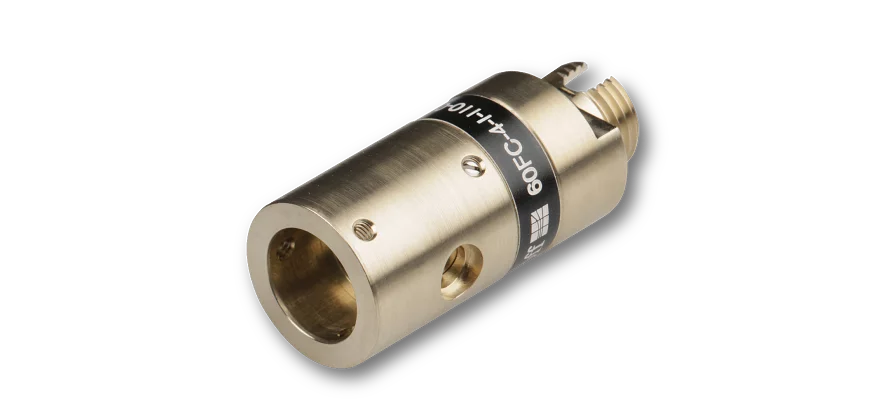The laser beam couplers series 60SMS are designed for compact and long-term stable coupling of single-mode laser radiation into a single-mode or polarization-maintaining fiber. For multimode applications please use the series 60FC-A19.5 fiber couplers.
Special RGB optics
A variety of special RGB coupling optics (achromats or apochromats) allows that the optimum focal length can be selected for broadband applications. All lenses are AR-coated. For an ideal Gaussian beam and standard fibers you can reach coupling efficiencies up to 80%.
High long-term stability
It‘s compact size as well as the high-resolution alignment mechanisms allow for a straight-forward, intuitive coupling procedure. The result is a fiber coupling with high thermal stability, pointing stability, that is vibration and shock-insensitive. Long-term stability tests (see figure on the right) have shown a power stability better than 3% for a temperature range of 15-35°C.
6* Degrees of freedom
In order to achieve optimum coupling efficiency the fiber coupler needs to provide certain degrees of freedom. You need to adjust
- the angle between laser beam and lens/fiber end-face
- the z-position of the lens
- adjust the polarization axis of the fiber to that of the laser source
- center the lens with respect to the laser beam
The fiber coupler provides all degrees of freedom necessary. It has a TILT adjustment, an independent focus adjustment, can be rotated 360°, and allows for lateral adjustment* using e.g. the adapter 60A19.5-F.
The TILT adjustment is used to maximize the lateral overlap between the mode field of the fiber and the focussed laser spot using 3 adjustment screws. 3 locking screws are used for fine-adjustment and to lock the position for an optimum mechanical stability.
Independent to the TILT adjustment, the distance between fiber end-face and coupling optics is adjusted by means of an eccentric key. The final focus setting is locked by means of two radially arranged clamping screws. Since the focus adjustment is independent, the z-position of the mode field diameter can be placed much more precisely.
The polarization alignment of the fiber to the polarization axis of the laser source is performed by rotating the laser beam coupler. The separation of the fiber coupler and the adapter necessary for centering is essential to allow for a full 360° freedom of rotation. The coupler has a tight-fit cylinder that can be placed into a Ø 19.5 mm receptacle of a corresponding adapter.
The beam can be centered with respect to the aperture of the coupling optics using e.g. the adapter 60A19.5-F.
Optimum lens performance
The angled polish of connectors of type APC causes the beam to exit in an angle and not parallel to the optical axis of the fiber. This is corrected by the pre-angled mechanical coupling axis of the coupler that compensates the beam deflection and you can use the lens centrically. This minimizes aberrations simply resulting from a non-ideal beam path through the lens.
Connector Type options
The fiber coupler can be equipped with receptacles of type FC PC (wide key*), FC APC (wide key*), ST or LSA (compatible with fiber connectors type DIN, AVIO and AVIM). SMA-905 (F-SMA) type receptacles are available for 0° and 5° or 8°-polish e.g. for SMA-905 High Power connectors. In case of FC or LSA with a spring loaded ferrule the fiber coupler has an additional grub screw to increase pointing stability. *Even though the fiber coupler has a wide key receptacle it still can be used with both narrow key and wide key fibers. More information can be found here.
Material Options
The fiber couplers are available in nickel silver (standard) or in amagnetic titanium. In case of titanium, the relative permeability is near 1 (µr=1.00005) making it almost transparent to magnetic fields. The linear coefficient of thermal expansion is close to that of the optics so that a thermal stability over a larger temperature range can be expected.











